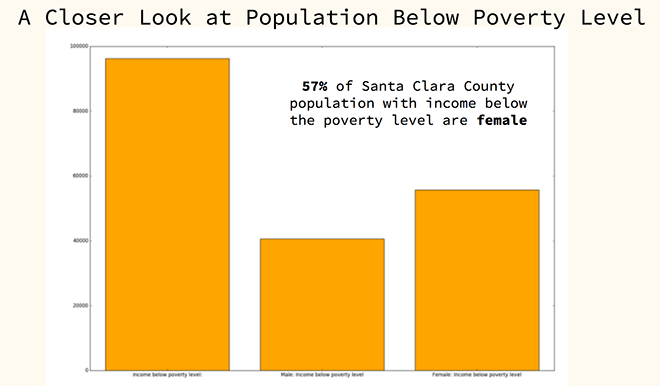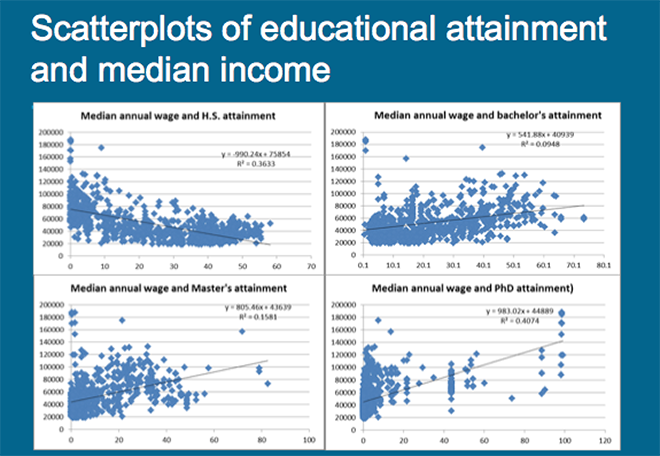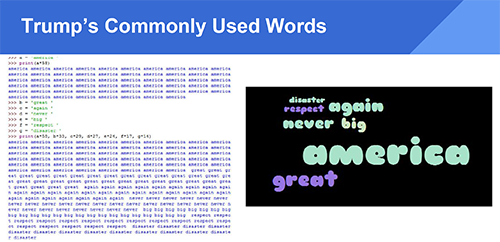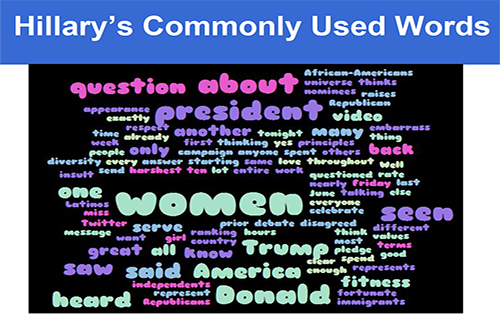Example Projects
ENGR 120 Student Project Examples (Fall 2016)
Team 1: Achieving the American Dream: Millennial Poverty
Students: Psychology Senior and Communications Senior
Description: Use microdata provided by the U.S. Census Bureau American Fact Finder. Analyze the
relationship between education, poverty rates, and age in Silicon Valley. Will also
examine the variables that strongly influence student poverty rates (i.e. compare
their parent’s income, etc.)
Team 2: Santa Clara County Condo Valuation Model and Interface
Students: Economics Senior, Economics Junior, and Economics Sophomore
Description: Will look at condo prices within Santa Clara County to offer a user who is in the
market for purchasing a condo an estimated price for a potential condo. The foundation
of the pricing calculator is a condo valuation regression model using statsmodel package.
Team 3: Memory Task Using Psychopy
Students: Psychology senior and psychology senior
Description: Demonstrate how chunking letters into familiar acronyms will facilitate with human
short-term memory. This project falls into the domain of cognitive psychology, and
will strive to quantitatively answer the question of exactly how chunking affects
human short-term memory.
Team 4: Automating the Process of Cortisol Analysis
Students: Psychology R&E graduate, Psychology graduate
Description: Simplify saliva sample analysis when examining cortisol samples in stress experiments.
Automate the calculation and filter the samples based on user input criteria.
Team 5: Create a Python package for linear algebra (matrices) calculations
Students: Applied Math sophomore and applied math sophomore
Description: The goal of our project is to be able to manipulate and use matrices within python.
Team 6: Recognition Memory Test
Students: psychology senior and psychology senior
Description: Analyze the correlation between sleep time and memory.
Team 7: Matching dog breed
Students: Psychology senior and psychology senior
Description: The current study will test whether or not participants will be able to correctly
differentiate between multiple dog breeds in a computer program by using psychopy
package.

Team 8: Searching Through HTML to Analyze the Usage of User-Inputted Terms
Students: Economics senior, economics senior, and psychology junior
Description: Create a program that takes in an URL and word or phrase in the shell, keeps track
of the amount of occurrences of the targeted word or phrase, and allows the user to
choose between storing the values into a .csv file or is displayed on the screen.
Team 9: Examining the Returns to Education on Wages, and the Correlation between Educational Attainment with Poverty Rates and Income Inequality
Students: economics seniors
Description: Investigate the extent to which higher levels of educational attainment (for example,
obtaining a bachelor’s degree as opposed to merely having a high school diplomat)
lead to higher wage levels. Estimating the return to education on increased wages
can demonstrate the extent to which pursuing a college degree is actually worth its
opportunity cost, i.e., the cost of tuition and the time required to obtain a college
degree, which could instead be spent by working full-time.

Team 10: A Visual Attention Experiment
Students: Psychology MA and psychology MA
Description: This project will attempt to replicate an experiment conducted by Rensink, O’Regan,
and Clark (1997) to measure for visual attention and change blindness.
Team 11: Attentional Capacities and Target Identification
Students: Psychology and psychology
Description: The purpose of the current study is to investigate the attentional capacities to correctly
identify target stimulant while simultaneously suppressing distractors.
Team 12: Word-frequency Comparison: Analysis of a Trump & Hillary debate
Students: Psychology, Engineering, Psychology
Description: In the most recent debates leading up to the election, the candidates resorted to
using a set of common terms in their debate as they have in the past. We also propose
that there will be a disparity between the complexity of their word choices, with
Donald Trump using more simplified language (i.e., less syllables per word) and Hillary
using more complicated language (i.e., more syllables per word).


Team 13: Working memory and physical activity in older adults
Students: Psychology
Description: Write a program to test older adult’s short term memory using an n-back task. An n-back
task is a memory task that asks participants to recall a stimulus that is a set number
(n) before the stimulus they last saw. This has been shown to be a strong indicator
of short term working memory function.